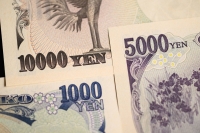Japan’s currency has dropped toward the level that triggered the first yen-buying intervention since 1998 in September, as yield differentials have widened.
The yen held steady at around ¥145.50 per dollar on Tuesday following six days of declines. On Sept. 22 last year, the Finance Ministry bought ¥2.84 trillion worth of yen when it weakened to ¥145.90.
The currency has depreciated about 3% since the Bank of Japan decided to tolerate higher benchmark bond yields on July 28, with Gov. Kazuo Ueda saying that volatility in the foreign-exchange market was a factor for the decision. Yield differentials between Japan and other major economies have widened further since then, putting even more pressure on Japan’s currency to weaken despite the BOJ’s move.
"We believe the Ministry of Finance will start pushing back in the 145-148 range,” Joey Chew, head of Asia foreign exchange research at HSBC Holdings, wrote in a note. "But, if it does not, short positions on yen will likely be rebuilt further.”
The Finance Ministry is in charge of ordering currency-market intervention in Japan, which is then carried out by the BOJ. U.S. benchmark 10-year Treasury yields are about 3.58 percentage points higher than their Japanese counterparts, widening from around 3.38 on July 28.



















With your current subscription plan you can comment on stories. However, before writing your first comment, please create a display name in the Profile section of your subscriber account page.